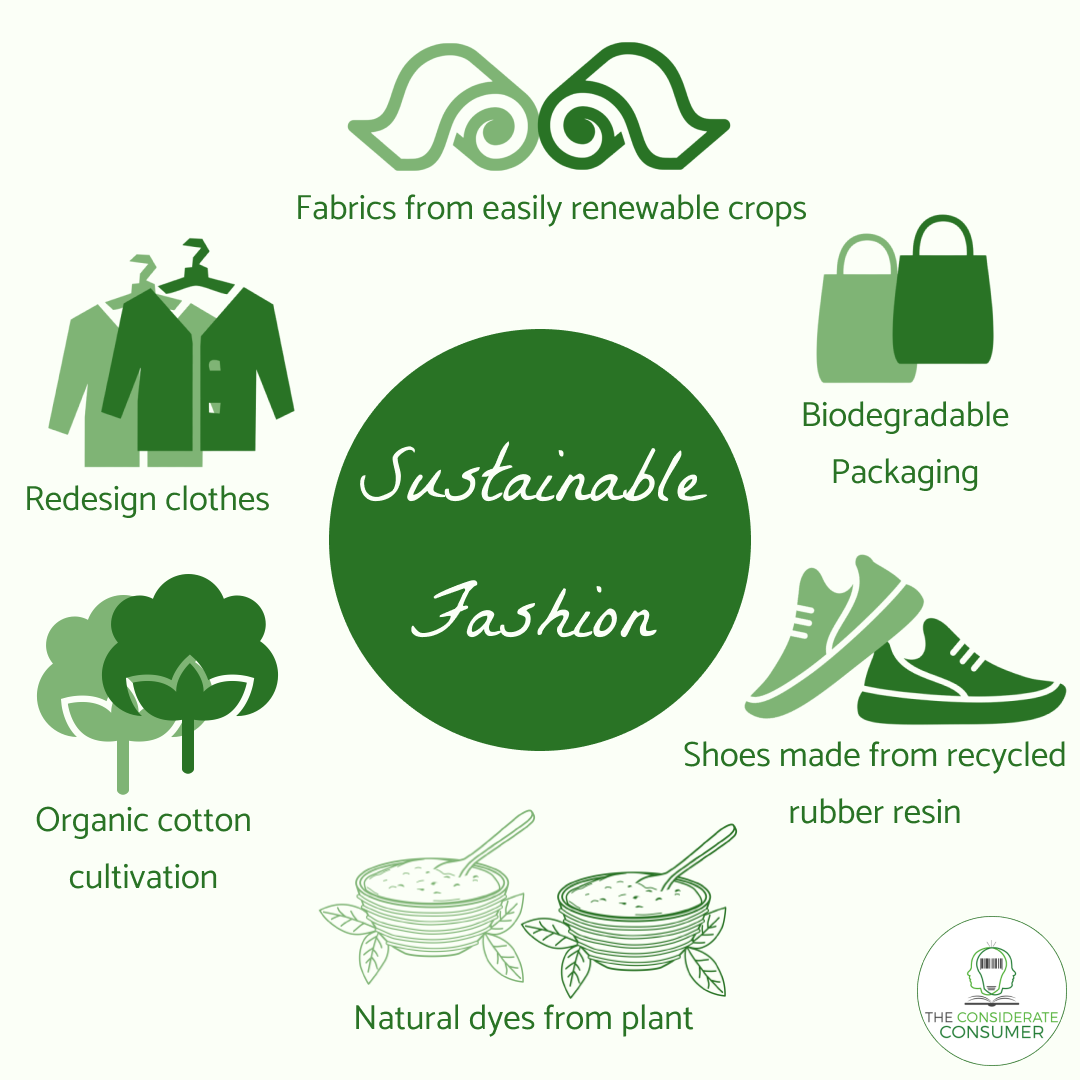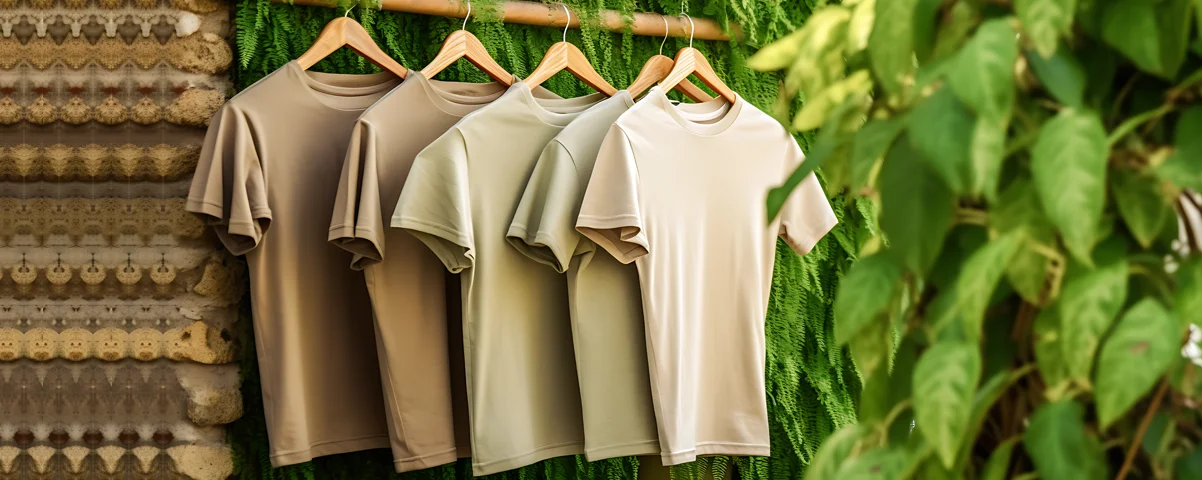Sustainable fashion focuses on eco-friendly practices in clothing production. It aims to reduce environmental impact and promote ethical labor.
Sustainable fashion promotes environmentally conscious choices in the fashion industry. It emphasizes using organic materials, reducing waste, and ensuring fair labor practices. Brands adopting sustainable fashion often prioritize recycled fabrics, water-efficient processes, and minimal carbon footprints. This approach not only benefits the planet but also supports ethical working conditions.
Consumers are increasingly aware of the environmental and social impacts of their purchases. As a result, sustainable fashion is gaining traction globally. By choosing sustainable options, individuals can contribute to a healthier environment and fairer labor standards. Sustainable fashion represents a shift towards a more responsible and transparent industry.

Credit: www.considerate-consumer.com
The Rise Of Sustainable Fashion
The world is waking up to the importance of sustainable fashion. More people are understanding the impact of their choices. This shift is changing the fashion industry. Sustainable fashion is now a big trend.
Environmental Impact Of Fast Fashion
Fast fashion is harmful to the environment. Factories produce clothes quickly and cheaply. This leads to a lot of waste. Many clothes end up in landfills. The production process also uses a lot of water and energy.
Chemicals used in dyeing pollute rivers. Animals and plants suffer. Fast fashion brands often use materials that do not biodegrade. This means they stay in the environment for a long time.
| Impact | Details |
|---|---|
| Water Usage | Large amounts of water are needed for production. |
| Waste | Many clothes are discarded after a short time. |
| Pollution | Harmful chemicals pollute water and soil. |
| Energy Consumption | High energy use contributes to carbon emissions. |
Consumer Shift Towards Eco-consciousness
Consumers are becoming more eco-conscious. They want to buy clothes that do not harm the planet. They look for brands that use sustainable materials. They prefer clothes that last longer.
Many people now buy second-hand clothes. Thrift stores and online resale shops are popular. This reduces waste and saves resources. Eco-conscious consumers also support ethical labor practices.
- Buying second-hand clothes
- Choosing brands with sustainable practices
- Supporting ethical labor standards
The rise of sustainable fashion shows a positive change. People care more about the environment and ethics. This trend is likely to grow.
Key Principles Of Sustainable Fashion
Sustainable fashion is about making clothes that are kind to the planet. It ensures clothes are made fairly. These key principles guide sustainable fashion. They promote eco-friendly and ethical practices.
Ethical Manufacturing Processes
Ethical manufacturing ensures fair wages. It provides safe working conditions. Workers are treated with respect. Factories follow strict labor laws. They avoid child labor and forced labor.
| Aspect | Details |
|---|---|
| Fair Wages | Employees receive fair pay for their work. |
| Safe Conditions | Workplaces are free from hazards. |
| Respect | Workers are treated with dignity. |
| Labor Laws | Factories follow local and international laws. |
Materials That Matter
Sustainable fashion uses eco-friendly materials. These materials have a low environmental impact. They are biodegradable or recyclable.
- Organic Cotton: Grown without harmful pesticides.
- Bamboo: Grows quickly and needs less water.
- Recycled Fabrics: Reduces waste by reusing materials.
- Hemp: Requires minimal water and no pesticides.
Using these materials helps reduce pollution. It also conserves water and energy.
2023’s Eco-chic Trends
Sustainable fashion is transforming our wardrobes in 2023. This year, eco-chic trends focus on reducing waste and using nature-friendly materials. These trends not only look stylish but also care for our planet.
Recycled And Upcycled Fabrics
Recycled fabrics are made from old clothes and plastic bottles. This reduces waste and gives new life to old items. Upcycled fabrics turn discarded materials into unique fashion pieces. This makes each piece special and eco-friendly.
| Fabric Type | Source Material | Benefits |
|---|---|---|
| Recycled Polyester | Plastic Bottles | Reduces Plastic Waste |
| Upcycled Denim | Old Jeans | Unique Designs |
| Recycled Cotton | Old Cotton Clothes | Saves Water |
Plant-based Clothing Options
Plant-based clothing uses materials from plants. These clothes are biodegradable and sustainable. Bamboo fabric is soft and breathable. Hemp fabric is durable and eco-friendly. Organic cotton is grown without harmful chemicals.
- Bamboo Fabric: Soft, breathable, and grows quickly.
- Hemp Fabric: Strong, durable, and requires less water.
- Organic Cotton: No harmful chemicals, better for skin.
Choosing plant-based fabrics helps the environment. It also supports sustainable farming practices. This makes fashion both stylish and eco-friendly.

Credit: www.nature.com
Innovations Shaping The Future
Sustainable fashion is rapidly evolving. Innovators are introducing new methods and materials. These changes aim to reduce environmental impact. Two key areas are biodegradable materials and zero-waste production techniques.
Biodegradable Materials
Biodegradable materials are breaking new ground. They decompose naturally, leaving no harmful residue. These materials include organic cotton, hemp, and bamboo. They require fewer resources to produce.
Let’s compare some popular biodegradable materials:
| Material | Characteristics |
|---|---|
| Organic Cotton | Soft, breathable, and less water-intensive |
| Hemp | Durable, grows quickly, needs little water |
| Bamboo | Fast-growing, naturally pest-resistant |
Zero-waste Production Techniques
Zero-waste production aims to eliminate fabric waste. Designers use smart patterns to use every piece of fabric. This method reduces landfill waste. It also saves resources.
Here are some techniques used in zero-waste production:
- Smart pattern making
- 3D knitting
- Recycling fabric scraps
These techniques create eco-friendly and stylish clothing. They help conserve resources and protect the planet.
Leading Brands In Sustainable Fashion
Sustainable fashion is gaining popularity. Many brands are taking significant steps to reduce their environmental impact. Here, we explore the brands leading the charge in sustainable fashion.
Trailblazers In Eco-friendly Apparel
Some brands are pioneers in eco-friendly apparel. They set high standards for the industry.
| Brand | Key Initiatives |
|---|---|
| Patagonia |
|
| Eileen Fisher |
|
| Stella McCartney |
|
Small Labels Making Big Changes
Small labels are also making significant contributions. They are innovative and committed to sustainability.
- Reformation – Focuses on sustainable fabrics and transparency.
- Everlane – Practices radical transparency and ethical manufacturing.
- Veja – Uses organic and fair trade materials for their sneakers.
These brands prove that sustainable fashion is possible. They inspire others to follow their lead.
How To Adopt Sustainable Fashion Practices
Adopting sustainable fashion practices is essential for reducing our environmental footprint. By making mindful choices, you can contribute to a healthier planet. Here are some practical tips to help you transition to sustainable fashion.
Building A Capsule Wardrobe
A capsule wardrobe consists of versatile and timeless pieces. These items can be mixed and matched easily. Start by selecting essential clothing items that suit your lifestyle. Choose neutral colors and classic styles. This way, your wardrobe remains stylish and functional for a long time.
Invest in high-quality pieces that last longer. Avoid fast fashion trends that fade quickly. Here is a simple table to get you started:
| Essential Item | Description |
|---|---|
| White T-shirt | Versatile and can be paired with anything |
| Black Pants | Classic and goes with any top |
| Denim Jacket | Timeless and adds style |
| Neutral Sweater | Perfect for layering in colder months |
Supporting Ethical Brands
Supporting ethical brands is a key step towards sustainable fashion. These brands focus on fair labor practices and eco-friendly materials. They ensure their workers are treated well and paid fairly. Look for certifications like Fair Trade, GOTS, and B Corp.
Here are some tips for finding ethical brands:
- Research the brand’s sustainability practices.
- Check for transparency in their supply chain.
- Read reviews and testimonials from other customers.
- Look for eco-friendly materials and production methods.
By choosing ethical brands, you support a better future for fashion. Remember, every purchase you make has an impact.
The Role Of Technology
Technology is revolutionizing sustainable fashion. It helps brands and consumers make better choices. This section explores how technology contributes to a greener fashion industry.
Blockchain For Transparency
Blockchain ensures transparency in the supply chain. It tracks every step from raw materials to finished products. This technology allows consumers to see the journey of their clothes.
With blockchain, brands can prove their sustainability claims. They can show that they use ethical sources. This builds trust with consumers.
A table can show the benefits of blockchain:
| Benefit | Description |
|---|---|
| Transparency | Tracks every step in the supply chain. |
| Trust | Builds consumer confidence in brand claims. |
| Accountability | Holds brands responsible for their practices. |
Apps For Conscious Shopping
Apps help consumers make eco-friendly shopping choices. They provide information about sustainable brands. Some apps even track your fashion carbon footprint.
Here are some popular apps:
- Good On You – Rates brands on sustainability.
- ThredUP – Promotes second-hand shopping.
- Depop – A marketplace for pre-loved fashion.
These apps empower consumers to shop responsibly. They make it easier to find sustainable options. Using these tools can significantly reduce your environmental impact.
Challenges And Opportunities
Sustainable fashion is rapidly gaining traction. Yet, this shift presents both challenges and opportunities. Brands and consumers alike face hurdles. But these challenges also open doors for innovation and growth.
Overcoming Greenwashing
Greenwashing is a significant challenge in sustainable fashion. Many brands claim to be eco-friendly without substantiating their claims. This practice misleads consumers and undermines genuine sustainability efforts.
To combat greenwashing, brands must be transparent. They should provide verifiable information about their practices. Certifications from recognized bodies can help. For example, the Global Organic Textile Standard (GOTS) or the Fair Trade Certification.
Consumers also play a role in overcoming greenwashing. They should educate themselves about sustainability standards. Asking the right questions and demanding transparency will push brands to be more honest.
The Economic Case For Sustainability
Sustainable fashion is not just about ethics. There is a strong economic case for it. Investing in sustainable practices can reduce costs in the long run. For instance, using durable materials reduces the need for frequent replacements.
Brands that adopt sustainable practices often see increased customer loyalty. Consumers today are more aware and prefer brands that prioritize the planet. This can lead to higher sales and better brand reputation.
Here is a simple comparison:
| Traditional Fashion | Sustainable Fashion |
|---|---|
| High waste production | Minimized waste |
| Short product lifespan | Long-lasting products |
| Low initial costs | Higher initial costs |
| Higher long-term costs | Reduced long-term costs |
Brands can also benefit from government incentives for sustainable practices. These incentives can offset the initial higher costs of sustainable materials and processes.
In summary, the challenges of greenwashing and the economic case for sustainability highlight the complex landscape of sustainable fashion. By addressing these challenges, we unlock numerous opportunities for growth and innovation.

Credit: www.worldfashionexchange.com
Frequently Asked Questions
What Are The 7 Rs Of Sustainable Fashion?
The 7 Rs of sustainable fashion are: Reduce, Reuse, Recycle, Repair, Repurpose, Resell, and Rent. These principles promote eco-friendly practices in the fashion industry.
What Are The Concepts Of Sustainable Fashion?
Sustainable fashion focuses on eco-friendly materials, ethical labor practices, reducing waste, recycling, and promoting longevity. It aims to minimize environmental impact while ensuring fair treatment for workers.
Why Is Sustainable Fashion So Important?
Sustainable fashion reduces environmental impact, conserves resources, and promotes fair labor practices. It supports a healthier planet and ethical consumerism.
Is Thrifting Considered Sustainable Fashion?
Yes, thrifting is considered sustainable fashion. It reduces waste, promotes recycling, and extends the life of clothing items.
Conclusion
Sustainable fashion is more than a trend; it’s a necessary shift. Embracing eco-friendly choices benefits both people and the planet. By supporting sustainable brands, we reduce waste and promote ethical practices. Make a conscious decision today to contribute to a greener future.
Your wardrobe can make a positive impact.
